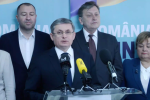
The competent European institutions will check how the 1.9 billion euro financial aid approved by the EU for the Republic of Moldova will be spent. MEP Siegfried Muresan said in an interview with IPN that there is an obligation of transparency regarding the final beneficiaries, the ways in which European funds are spent.
"If there are delays or things not accomplished on those reforms, then the European Commission will have to block some payments, I hope it will not come to that, but the rules are very clear," Muresan said.
The money will come twice a year and the tranches are not all the same amount.
"This will be decided after the authorities in Chisinau submit the plan. So, they will be about the same order of magnitude, but it also depends on the investments that will be implemented each semester and the reforms that will be implemented," the MEP said.
The European Union proposed a €1.8 billion economic aid package to Moldova at the end of last year, which was increased to €1.9 billion during negotiations. The immediate support to be offered to Moldova has also increased.
"We wanted the Republic of Moldova to receive the most comprehensive support as quickly as possible and increasing this pre-financing is the best way. We have increased it from 7% to 18%, i.e. from €115 million to €315 million," Muresan said.
The authorities in Chisinau have to present to the European Commission the plan according to which they will absorb this money, what investments they want to make and what reforms they will carry out. Pre-financing could start at the end of April or in May.
Muresan also explained the proportion between funds and loans.
"We have a share of about 20% non-reimbursable funds, money that the Republic of Moldova will never have to return to the European Union, and the rest are loans, they are reimbursable funds, money that the Republic of Moldova will return, but for an extremely long period of time, over the next decades, and at a very low interest rate," explained Siegfried Muresan.












